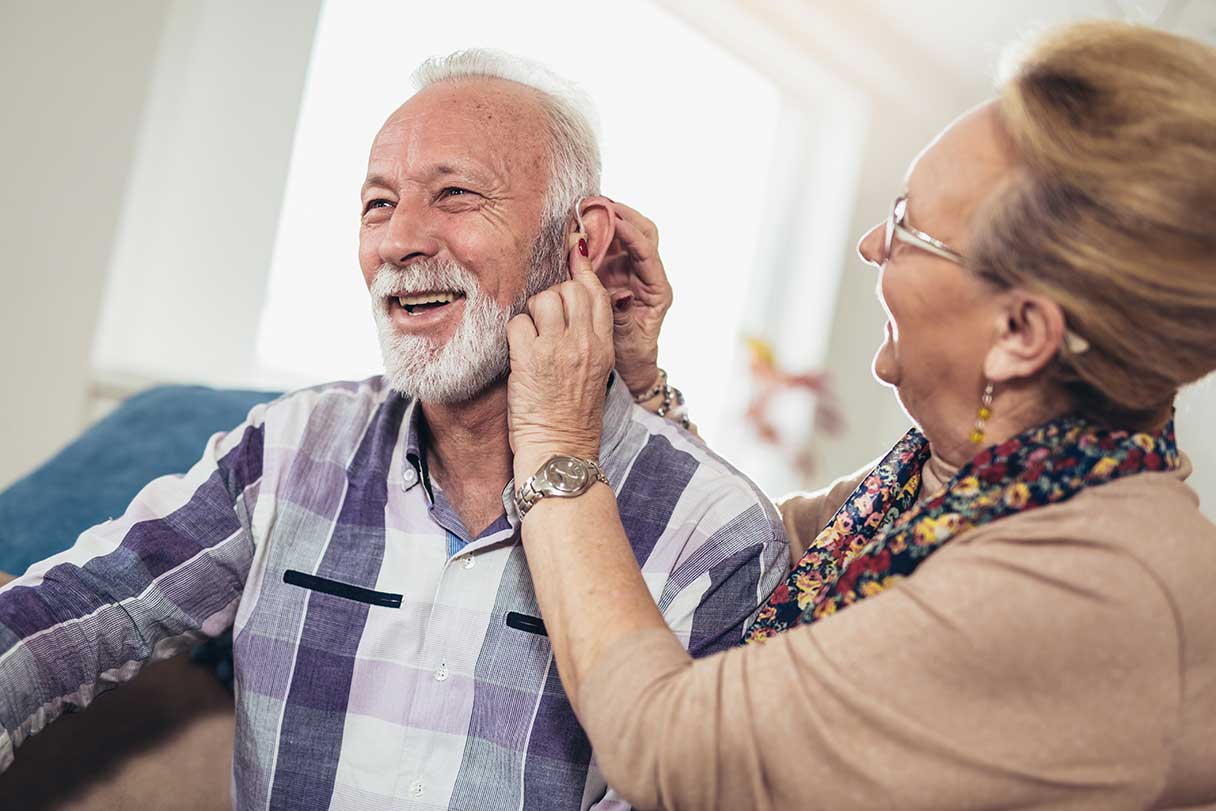Seventy percent of surveyed Americans consider their hearing a priority, yet only 10% have visited an audiologist in the past year, according to a recent study.1 Left untreated, hearing loss may lead to social isolation, depression and cognitive decline.2 The good news is that many types of hearing loss are treatable. Whether you have mild or severe hearing loss, hearing aids may improve the ability to connect and engage with the world around you.2
Behind-the-ear (BTE) hearing aids are one of the most popular styles because they offer versatility and effectiveness for a wide range of hearing issues.3 These devices are especially helpful if you have severe hearing loss because they hold a larger receiver and better amplify the volume.4 If you're considering BTE hearing aids, understanding their costs, financing options and features can help you make a more informed decision.
How Do BTE Hearing Aids Work?
Using a microphone, hearing aids capture sound waves and convert them into electrical signals before amplifying and sending them to the ear via a speaker.3 BTE devices are what most people think of when it comes to traditional hearing aids. It consists of a curved case that rests behind the ear, with a thin tube or wire connecting it to an earpiece that fits inside the ear canal.3
Despite their classic design, BTE hearing aids feature modern technology, including:3
- Bluetooth® capabilities
- Customizable settings4
- Digital functionality
- Noise cancellation4
- Programmability
- T-coil (telephone compatibility)
What Do They Treat?
BTE hearing aids are ideal for people with a wide range of hearing loss, from mild to severe.3 They are also suitable for children and individuals with dexterity challenges, as they are easier to handle than smaller hearing aids.5
| Type of BTE hearing aid | Description | Best for |
|---|---|---|
| BTE (standard) |
|
|
| Mini BTE/0pen-fit |
|
|
| Receiver-in-the-ear (RITE) |
|
|
How Much Do BTE Hearing Aids Cost?
The national average cost* for a standard BTE hearing aid is $1,562 per device, but the price ranges between $1,233 and $3,037.7
Several factors influence the cost of behind-the-ear hearing aids. For example, devices tailored to your specific hearing needs and professional services like hearing tests, fittings and follow-up appointments may impact your overall cost.
Additional cost considerations to keep in mind include:
- Accessories like cleaning kits
- Maintenance and repairs
- Replacement batteries or chargers
Calculate the cost of a BTE hearing aid device near you*

Explore procedure costs in your area
Average cost for a BTE hearing aid by state/district
The table below lists the average cost* of different types of BTE hearing aid devices for all 50 states and the District of Columbia:7
| State/District | BTE (standard) | Mini BTE/open-fit | Receiver-in-the-ear (RITE) |
|---|---|---|---|
| Alabama | $1,356 | $1,293 | $1,683 |
| Alaska | $1,894 | $1,837 | $2,387 |
| Arizona | $1,587 | $1,504 | $2,024 |
| Arkansas | $1,373 | $1,316 | $1,698 |
| California | $1,926 | $1,913 | $2,448 |
| Colorado | $1,554 | $1,549 | $1,982 |
| Connecticut | $1,664 | $1,578 | $1,969 |
| Delaware | $1,554 | $1,505 | $1,959 |
| District of Columbia | $2,013 | $2,043 | $2,619 |
| Florida | $1,570 | $1,508 | $1,953 |
| Georgia | $1,412 | $1,390 | $1,749 |
| Hawaii | $2,424 | $2,537 | $3,024 |
| Idaho | $1,597 | $1,534 | $1,990 |
| Illinois | $1,540 | $1,429 | $1,862 |
| Indiana | $1,407 | $1,332 | $1,749 |
| Iowa | $1,360 | $1,300 | $1,744 |
| Kansas | $1,393 | $1,343 | $1,730 |
| Kentucky | $1,425 | $1,398 | $1,822 |
| Louisiana | $1,440 | $1,389 | $1,818 |
| Maine | $1,529 | $1,531 | $1,999 |
| Maryland | $1,707 | $1,717 | $2,268 |
| Massachusetts | $1,903 | $1,670 | $2,409 |
| Michigan | $1,442 | $1,364 | $1,797 |
| Minnesota | $1,467 | $1,426 | $1,856 |
| Mississippi | $1,402 | $1,322 | $1,618 |
| Missouri | $1,395 | $1,313 | $1,725 |
| Montana | $1,527 | $1,482 | $1,931 |
| Nebraska | $1,397 | $1,347 | $1,759 |
| Nevada | $1,575 | $1,494 | $1,927 |
| New Hampshire | $1,610 | $1,583 | $2,058 |
| New Jersey | $1,752 | $1,683 | $2,211 |
| New Mexico | $1,390 | $1,381 | $1,795 |
| New York | $1,632 | $1,589 | $2,146 |
| North Carolina | $1,433 | $1,394 | $1,816 |
| North Dakota | $1,428 | $1,382 | $1,797 |
| Ohio | $1,430 | $1,384 | $1,833 |
| Oklahoma | $1,350 | $1,334 | $1,681 |
| Oregon | $1,656 | $1,607 | $2,131 |
| Pennsylvania | $1,512 | $1,473 | $1,892 |
| Rhode Island | $1,634 | $1,539 | $2,062 |
| South Carolina | $1,437 | $1,402 | $1,837 |
| South Dakota | $1,435 | $1,368 | $1,803 |
| Tennessee | $1,400 | $1,327 | $1,761 |
| Texas | $1,444 | $1,385 | $1,827 |
| Utah | $1,580 | $1,473 | $1,902 |
| Vermont | $1,615 | $1,609 | $2,047 |
| Virginia | $1,534 | $1,465 | $1,908 |
| Washington | $1,731 | $1,706 | $2,253 |
| West Virginia | $1,368 | $1,356 | $1,707 |
| Wisconsin | $1,450 | $1,405 | $1,845 |
| Wyoming | $1,473 | $1,408 | $1,799 |
What to Expect When Getting BTE Hearing Aids
If you are experiencing hearing loss, you may consult a hearing professional, such as an audiologist, an ear, nose and throat (ENT) specialist or a hearing aid specialist. Each plays a unique role in diagnosing and addressing hearing issues.
Once your hearing has been tested and your medical history has been evaluated, your audiologist or physician will prescribe your hearing aid based on your specific needs and preferences. You can expect the process of obtaining and using your device to involve the following steps:8
- Fitting and customization ensure that the device amplifies sounds appropriately for your level of hearing loss.
- Education and training provide instructions on how to use, clean and maintain your hearing aid.
- Follow-up appointments fine-tune the hearing aid and address any issues you may encounter.
- Ongoing maintenance helps make sure your device lasts as long as possible and includes cleaning the device and replacing batteries, filters and other parts.
5 Tips to Help You Adjust to Wearing BTE Hearing Aids
Using hearing aids for the first time involves some time to adjust. By following these tips, you can make the transition to wearing BTE hearing aids smoother and more enjoyable.
1. Start slowly
To start, you won't be wearing your hearing aids 24/7. Instead, you should gradually increase the amount of time you wear them each day. Begin with a few hours and gradually extend the duration as you feel comfortable.9
2. Familiarize yourself with the controls
Each hearing aid device is different and often customizable. Take some time to learn about the different settings and controls on your hearing aids. Understanding how to adjust volume and switch programs can enhance your listening experience.
3. Practice listening in different environments
Wear your hearing aids in various settings, like quiet rooms, busy cafes and outdoor areas. This can help you adjust to different sound levels and improve your ability to focus on conversations.
4. Be patient with yourself
It’s normal to feel overwhelmed or frustrated at first. Give yourself grace and allow time to adapt to the new sounds and sensations. If certain sounds seem too loud or distracting, consult your audiologist for adjustments.9
5. Seek support and guidance
Don’t hesitate to reach out to your audiologist for any questions or concerns. They can provide valuable tips and adjustments to help ensure your hearing aids are working optimally for you.9
Does Insurance Cover BTE Hearing Aids?
Most private insurance plans do not fully cover hearing aids, but some offer partial coverage or reimbursement. For example, certain plans may cover hearing tests or fittings but not the devices themselves.10
Additionally, some states mandate insurance coverage for hearing aids, so your location can play a significant role in determining your benefits.11
To determine your coverage, follow these steps:
- Review your insurance policy documents for hearing aid benefits.
- Contact your insurance provider and ask about coverage for hearing aids, fittings and follow-up care.
- Explore reimbursement options if direct coverage is not available.
How can I pay for behind-the-ear (BTE) hearing aids?
There are several ways you can handle the out-of-pocket expenses for hearing aids. If your insurance doesn't cover them, you might be able to use a tax-free Health Savings Account (HSA) or Flexible Spending Account (FSA) to pay for the device.11
Don't Put Your Hearing on Hold
Behind-the-ear hearing aids are a versatile and effective solution for many types of hearing loss. Talk to your audiologist to find the best BTE hearing aid for your needs.
Financing Ear Care With the CareCredit Credit Card
The CareCredit credit card can help you pay for hearing care, including regular hearing tests, screenings and more.** Use our Acceptance Locator to find a hearing specialist near you that accepts CareCredit. Continue to invest in your wellness journey by downloading the CareCredit Mobile App to manage your account, find a provider on the go, and easily access the Well U blog for more great articles, podcasts and videos.
In addition to hearing care, you can also use your CareCredit credit card for dentistry, cosmetic, pet care, vision, health systems, dermatology, pharmacy purchases, spa treatments and so much more within the CareCredit network. How will you invest in your health and wellness next?
Author Bio
Pamela Cagle, R.N., has extensive experience in a range of clinical settings, including ER, surgical and cardiovascular. For the past decade, she has leveraged her nursing experience in writing for health and technology publications such as AARP, VKTR, National Council on Aging and others. She is passionate about blending her medical and storytelling expertise to bring authenticity to health and wellness topics.







